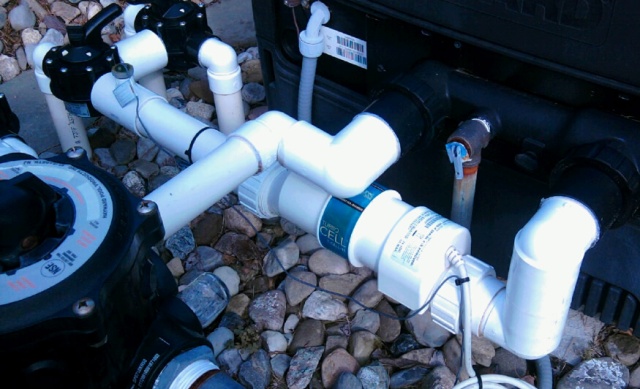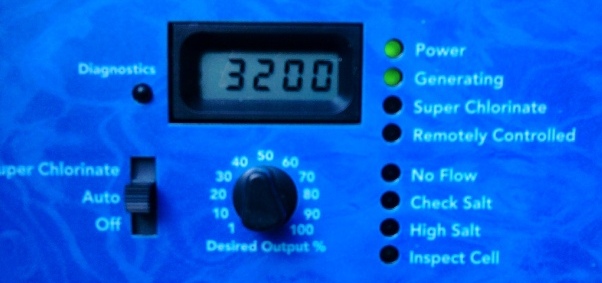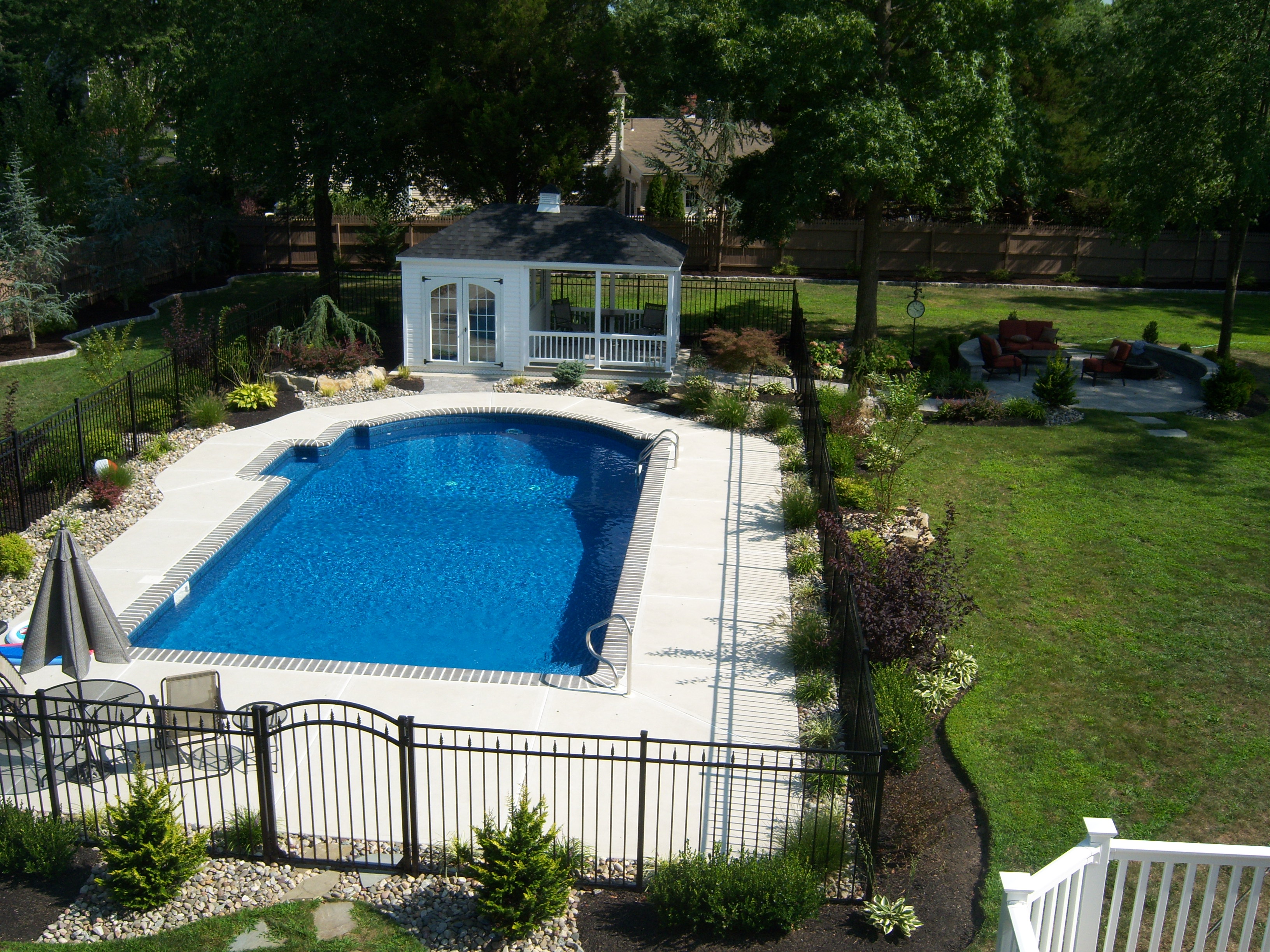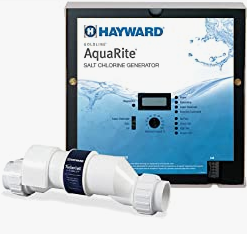2022 Update: We installed our swimming pool a little over two years ago, and going through the research alone was a tremendous effort. There are so many items to consider regarding the design and construction, and then all the potential pool accessories as well; it’s frankly a little overwhelming. And if you’re going through the same research right now (for above ground pools or an in ground pool), one of the key choices you’re going to be faced with is that of a pool chlorinator.
Pool Chlorine “Back in the Day” & Today
Growing up, we had a small pool for a little while that my brother and I helped to buy with earnings from our summer jobs. It was a genuine family effort – we all pitched in to buy the pool and to maintain it. Back then, we bought chlorine tablets and put them into a floating distribution canister to keep the pool water sanitized. It was simple, and it worked just fine. Today, in addition to the option of using chlorine tablets, what you’re sure to hear from any pool company are the virtues of a salt water chlorine generation system.
I’m not going to go into much detail here – but I want to give a basic sense of what exactly these systems are, how they work, what you do to maintain them and give you my experience over the past few seasons as to whether or not they actually keep the pool clean!
What Exactly is a Salt Water Chorinator?
In essence, a salt water chlorine system uses salt from your pool water to generate chlorine.
The process is renewable, which is the beauty of the entire system. When you initially fill your pool, you add bags of pool salt to the water with some precision to get just-the-right concentration. Then, as the filter runs, salt water is forced through the chlorine generator (hardware adjacent to your filter) – and chlorinated water comes out.

There’s a photo of my Aqua Rite “salt chlorinator cell” (now “Hayward/AquaRite) above to give you a feel for what this can look like. (And click to get more detail from Amazon if you like!)
How does a Salt Chlorinator Work?
Table salt (which is pretty much what’s dumped in your pool – though pool salt won’t be iodized) is made of chlorine and sodium. At a molecular level, there’s one chlorine atom bonded to each sodium atom. The salt cell is a chamber with an oscillating electrical voltage that rips the chlorine and sodium atoms apart as they pass through, effectively liberating “free chlorine” (and sodium) into the pool water. When free chlorine eventually gets close enough to a free sodium atom – they can recombine to form salt again. Thus, this is a recurring cycle. But while there’s free chlorine in the water, it creates a hostile environment for algae and bacteria – essentially sanitizing the pool.
Salt Water Pool Maintenance
The pool water will need to be maintained at the proper concentration of salt – and this is quite easy to do because unless you’re removing water from the pool or adding fresh water, the concentration really shouldn’t change very much at all. While water can evaporate – the salt does not.
So what are the specific ways the concentration can change? Backwashing and excessive “splash loss” will surely remove salt (and water) from your pool. When you then refill, you’ll have a slightly reduced salt concentration. If excessive rain raises your pool water level, this will also decrease the salt concentration. But in all cases, there’s very probably going to be a “reading” on your salt system control panel that will give you the number. You need to check this once in a while, and then tune as necessary. My system operates at peak efficiency at a salt concentration of 3200 parts per million; you can see my Aqua Rite chlorinator control-panel just below…

In practice, over my not-quite-three seasons so far, I’ve found that my salt levels have only needed to be tuned once a season when the pool is opened – and this has been primarily because I drain water (along with dissolved salt) periodically over the winter to keep the pool from overflowing!
Another thing you’ll need to do periodically is clean the salt cell – there are instructions you’ll receive from your manufacturer. I did it last season for the first time, and it took me less than 30 minutes.
Other Salt Water Pool Chlorinator Questions I’ve Received…
I’m just going to free form this, but if you’re thinking about getting a chlorine generation system for a new (or existing) pool, the following tidbits are quite simply based on my experiences as a pool owner:
Question: Have I ever had to add tablet chlorine over the time I’ve had my saltwater pool to supplement the chlorine generation system?
Answer: No.
Question: Can I add tablet chlorine if I want to?
Answer: Yes. But be careful here – as some of the newer chlorinators, as I understand it, may void the warranty if this is detected.
Question: What if the pool needs to be shocked during the season?
Answer: A chlorine generation system can handle this as well. There’s a dial on my system that will effectively “increase the voltage” and thus the amount of free chlorine added to the pool. There’s even a “super-chlorinate” button on my model which is the equivalent of a shock treatment; I use this two or three times a season, just to be preventative – especially if I have a lot of people coming over. You can see both of these controls in the photo provided above.
Question: Does the pool taste salty?
Answer: A tiny bit, yes. But NOTHING like ocean water. I’d say it tastes less salty than tears.
Question: Does the salt water kill the pool landscaping or grass if it’s splashed?
Answer: I was particularly worried about this as salt is, of course, corrosive – but there have been no problems with my landscaping or adjacent lawn at all. Even the pool ladder and handrail both still look great.

Question: Does the water feel different?
Answer: This is a really interesting question. The answer is actually “yes,” from my perspective. The chlorine tablets that you buy contain much more than free chlorine, which is highly reactive and chemically unstable; there are additional chemical stabilizers and binding agents added to these tablets. With a chlorine generation system you don’t have any of this extra stuff in your pool water. The water is gentler on your eyes (for sure), and some say it even “feels softer.”
Question: Will chlorine be generated when the filter is off?
Answer: No.
Question: Does the filter need to run longer than usual for the chlorinator to work?
Answer: My filter and chlorinator run for 8 hours a day together, and I have an 18 x 36 foot pool. The amount of time you need to run your system will surely vary with your pool and climate conditions, but I haven’t given any extra consideration to running the filter for extra chlorine. Besides – I can just turn up the dial on the chlorinator if I want a higher rate of chlorine generation over the time that the filter runs.
Bottom Line: Do Salt Water Pool Chorinator Systems Work?
In my experience: Absolutely 100% Yes.
It hasn’t quite been three full years for me yet, and I cannot say what will happen in the seasons to come, but as of today – I definitely wouldn’t consider building another pool without a chlorine generation system. We just don’t have to do very much maintenance on the pool at all. We vacuum about once a week, check on the salt levels and have the water tested overall once in a while. The pool has never “gone green” on us, and I’ve never spent one dollar on chlorine. The chlorination system has been a pleasure.
So far, anyway!
Any other suggestions, stories or words of wisdom anyone can share?


Thank you loads for sharing your experience, Mark! I’d also like to share how to prolong salt cells’ lifespan, which is an integral part of the saltwater system. Hopefully, someone will find it helpful – after all, salt cells are pretty costly to replace. Unfortunately, many people mistakenly think their cell is used up because the cell hasn’t been thoroughly cleaned.
The titanium plates in salt cells slowly accumulate calcium mineral scaling. It needs to be periodically cleaned because scaling and debris impede the ability of the salt cell to operate. Cleaning basically involves taking 5-10 minutes to soak the cell in a weak acid or vinegar solution that will dissolve the build-up.
Wonderful additional inputs, Olivia – thank you so much for sharing your insights!!
I have an issue with a lot of flakes of calcium coming out of my return. This is in my salt water pool. Any suggestions on how to eliminate this?
Hmm… I don’t like the sound of this, Danny. I wonder – do you have a DE filter, by chance? Here’s what I’m thinking: Salt chlorinators don’t do anything with Calcium. DE filters, however, work with Diatomaceous earth – a white powdery substance that’s mainly Silica, but can look a lot like Calcium. That said – if you have a DE filter (working with your salt water pool and chlorinator), and the internal grids (that hold the DE) get damaged, then DE can find its way out of your returns – and look, perhaps, like Calcium.
Suggest you get a handyman (or pool guy) over to look at this – and if you don’t have one, you can find a local one right here. Just be sure the person you hire has pool-specific experience. You don’t want a wallpaper person opening your pool filter. But the key starting question, to me, remains this per above: Do you have a DE filter?
Hope this is of some help!
Is the salt water essence the same as the contents of a bag of salt?
It is indeed, Judith – sodium chloride. And when the salt molecule is ripped apart by the salt cell (via electrical voltage), the free chlorine does its job in the pool. Until it recombines with a sodium ion – turning back to salt, and thus making the entire process renewable.
Hi Mark
This system sounds a whole lot easier than the ones I have seen my friends use where they constantly have to check the salt/chlorine levels and still seem to turn green very easily!